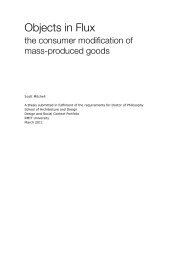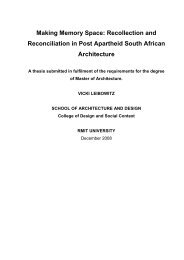- Page 1 and 2: Detection of Enteric Bacteria in Ra
- Page 3 and 4: Acknowledgement I would first like
- Page 5 and 6: Table of Content List of Abbreviati
- Page 7 and 8: 2.1.6. Media and solutions for tiss
- Page 9 and 10: Chapter 3: The Detection of Enteric
- Page 11 and 12: 4.2.6. The transfer ability of anti
- Page 13 and 14: Term Meaning AMP Ampicillin AMO Amo
- Page 15 and 16: LDC Lysine Decarboxylase MDR Multid
- Page 17 and 18: List of Figures Figure 1.1: The pos
- Page 19 and 20: Figure 5.5: Agarose gel electrophor
- Page 21 and 22: Table 4.2: E. coli isolates used to
- Page 23 and 24: Abstract 1 ABSTRACT Food is essenti
- Page 25 and 26: 3 ABSTRACT was also observed. In co
- Page 27 and 28: 5 ABSTRACT The ownership of resista
- Page 29 and 30: Chapter 1: Introduction 1.1. Enteri
- Page 31 and 32: 9 CHAPTER 1: INTRODUCTION and about
- Page 33 and 34: 11 CHAPTER 1: INTRODUCTION (20.7%),
- Page 35: 13 CHAPTER 1: INTRODUCTION Typhoid
- Page 39 and 40: 17 CHAPTER 1: INTRODUCTION and oral
- Page 41 and 42: 19 CHAPTER 1: INTRODUCTION the spec
- Page 43 and 44: 21 CHAPTER 1: INTRODUCTION Unlike o
- Page 45 and 46: 23 CHAPTER 1: INTRODUCTION is essen
- Page 47 and 48: 25 CHAPTER 1: INTRODUCTION There ar
- Page 49 and 50: 27 CHAPTER 1: INTRODUCTION Studies
- Page 51 and 52: 29 CHAPTER 1: INTRODUCTION antibiot
- Page 53 and 54: 31 CHAPTER 1: INTRODUCTION Stobberi
- Page 55 and 56: 33 CHAPTER 1: INTRODUCTION The deve
- Page 57 and 58: 35 CHAPTER 1: INTRODUCTION Plasmids
- Page 59 and 60: Figure 1.2: General structures of i
- Page 61 and 62: 39 CHAPTER 1: INTRODUCTION horizont
- Page 63 and 64: 41 CHAPTER 1: INTRODUCTION 1998; Ri
- Page 65 and 66: 43 CHAPTER 1: INTRODUCTION Salmonel
- Page 67 and 68: 45 CHAPTER 1: INTRODUCTION Morabito
- Page 69 and 70: 47 CHAPTER 2: GENERAL MATERIALS AND
- Page 71 and 72: Petri dish Nunc, Denmark 49 CHAPTER
- Page 73 and 74: 51 CHAPTER 2: GENERAL MATERIALS AND
- Page 75 and 76: 53 CHAPTER 2: GENERAL MATERIALS AND
- Page 77 and 78: 2.1.3. General media and solutions
- Page 79 and 80: 57 CHAPTER 2: GENERAL MATERIALS AND
- Page 81 and 82: 59 CHAPTER 2: GENERAL MATERIALS AND
- Page 83 and 84: Trypan blue solution: 1% (w/v) tryp
- Page 85 and 86: 63 CHAPTER 2: GENERAL MATERIALS AND
- Page 87 and 88:
2.2.2.1.3. Isolation and identifica
- Page 89 and 90:
67 CHAPTER 2: GENERAL MATERIALS AND
- Page 91 and 92:
Table 2.2: Bacterial strains and ba
- Page 93 and 94:
2.2.3.2. Inoculation of test plates
- Page 95 and 96:
2.2.4.3. Polymerase Chain Reaction
- Page 97 and 98:
75 CHAPTER 2: GENERAL MATERIALS AND
- Page 99 and 100:
77 CHAPTER 2: GENERAL MATERIALS AND
- Page 101 and 102:
79 CHAPTER 2: GENERAL MATERIALS AND
- Page 103 and 104:
CHAPTER 3: THE DETECTION OF ENTERIC
- Page 105 and 106:
CHAPTER 3: THE DETECTION OF ENTERIC
- Page 107 and 108:
CHAPTER 3: THE DETECTION OF ENTERIC
- Page 109 and 110:
CHAPTER 3: THE DETECTION OF ENTERIC
- Page 111 and 112:
CHAPTER 3: THE DETECTION OF ENTERIC
- Page 113 and 114:
CHAPTER 3: THE DETECTION OF ENTERIC
- Page 115 and 116:
CHAPTER 3: THE DETECTION OF ENTERIC
- Page 117 and 118:
CHAPTER 3: THE DETECTION OF ENTERIC
- Page 119 and 120:
CHAPTER 3: THE DETECTION OF ENTERIC
- Page 121 and 122:
CHAPTER 3: THE DETECTION OF ENTERIC
- Page 123 and 124:
CHAPTER 3: THE DETECTION OF ENTERIC
- Page 125 and 126:
CHAPTER 3: THE DETECTION OF ENTERIC
- Page 127 and 128:
CHAPTER 3: THE DETECTION OF ENTERIC
- Page 129 and 130:
CHAPTER 3: THE DETECTION OF ENTERIC
- Page 131 and 132:
CHAPTER 3: THE DETECTION OF ENTERIC
- Page 133 and 134:
CHAPTER 3: THE DETECTION OF ENTERIC
- Page 135 and 136:
CHAPTER 3: THE DETECTION OF ENTERIC
- Page 137 and 138:
CHAPTER 3: THE DETECTION OF ENTERIC
- Page 139 and 140:
CHAPTER 3: THE DETECTION OF ENTERIC
- Page 141 and 142:
CHAPTER 3: THE DETECTION OF ENTERIC
- Page 143 and 144:
CHAPTER 3: THE DETECTION OF ENTERIC
- Page 145 and 146:
CHAPTER 3: THE DETECTION OF ENTERIC
- Page 147 and 148:
CHAPTER 3: THE DETECTION OF ENTERIC
- Page 149 and 150:
CHAPTER 3: THE DETECTION OF ENTERIC
- Page 151 and 152:
CHAPTER 3: THE DETECTION OF ENTERIC
- Page 153 and 154:
CHAPTER 3: THE DETECTION OF ENTERIC
- Page 155 and 156:
CHAPTER 3: THE DETECTION OF ENTERIC
- Page 157 and 158:
CHAPTER 3: THE DETECTION OF ENTERIC
- Page 159 and 160:
CHAPTER 3: THE DETECTION OF ENTERIC
- Page 161 and 162:
CHAPTER 4: MOLECULAR GENETIC MECHAN
- Page 163 and 164:
4.2. Method CHAPTER 4: MOLECULAR GE
- Page 165 and 166:
CHAPTER 4: MOLECULAR GENETIC MECHAN
- Page 167 and 168:
No. CHAPTER 4: MOLECULAR GENETIC ME
- Page 169 and 170:
CHAPTER 4: MOLECULAR GENETIC MECHAN
- Page 171 and 172:
CHAPTER 4: MOLECULAR GENETIC MECHAN
- Page 173 and 174:
CHAPTER 4: MOLECULAR GENETIC MECHAN
- Page 175 and 176:
CHAPTER 4: MOLECULAR GENETIC MECHAN
- Page 177 and 178:
CHAPTER 4: MOLECULAR GENETIC MECHAN
- Page 179 and 180:
CHAPTER 4: MOLECULAR GENETIC MECHAN
- Page 181 and 182:
CHAPTER 4: MOLECULAR GENETIC MECHAN
- Page 183 and 184:
CHAPTER 4: MOLECULAR GENETIC MECHAN
- Page 185 and 186:
CHAPTER 4: MOLECULAR GENETIC MECHAN
- Page 187 and 188:
Isolate name Sources CHAPTER 4: MOL
- Page 189 and 190:
CHAPTER 4: MOLECULAR GENETIC MECHAN
- Page 191 and 192:
CHAPTER 4: MOLECULAR GENETIC MECHAN
- Page 193 and 194:
CHAPTER 4: MOLECULAR GENETIC MECHAN
- Page 195 and 196:
CHAPTER 4: MOLECULAR GENETIC MECHAN
- Page 197 and 198:
CHAPTER 4: MOLECULAR GENETIC MECHAN
- Page 199 and 200:
CHAPTER 4: MOLECULAR GENETIC MECHAN
- Page 201 and 202:
CHAPTER 4: MOLECULAR GENETIC MECHAN
- Page 203 and 204:
CHAPTER 4: MOLECULAR GENETIC MECHAN
- Page 205 and 206:
CHAPTER 4: MOLECULAR GENETIC MECHAN
- Page 207 and 208:
CHAPTER 4: MOLECULAR GENETIC MECHAN
- Page 209 and 210:
Isolates Sources CHAPTER 4: MOLECUL
- Page 211 and 212:
CHAPTER 4: MOLECULAR GENETIC MECHAN
- Page 213 and 214:
CHAPTER 4: MOLECULAR GENETIC MECHAN
- Page 215 and 216:
Integron size (kb CHAPTER 4: MOLECU
- Page 217 and 218:
CHAPTER 4: MOLECULAR GENETIC MECHAN
- Page 219 and 220:
CHAPTER 4: MOLECULAR GENETIC MECHAN
- Page 221 and 222:
CHAPTER 4: MOLECULAR GENETIC MECHAN
- Page 223 and 224:
CHAPTER 4: MOLECULAR GENETIC MECHAN
- Page 225 and 226:
CHAPTER 4: MOLECULAR GENETIC MECHAN
- Page 227 and 228:
CHAPTER 4: MOLECULAR GENETIC MECHAN
- Page 229 and 230:
CHAPTER 4: MOLECULAR GENETIC MECHAN
- Page 231 and 232:
CHAPTER 4: MOLECULAR GENETIC MECHAN
- Page 233 and 234:
CHAPTER 4: MOLECULAR GENETIC MECHAN
- Page 235 and 236:
CHAPTER 4: MOLECULAR GENETIC MECHAN
- Page 237 and 238:
CHAPTER 4: MOLECULAR GENETIC MECHAN
- Page 239 and 240:
CHAPTER 4: MOLECULAR GENETIC MECHAN
- Page 241 and 242:
CHAPTER 5: PATHOGENICITY OF SALMONE
- Page 243 and 244:
CHAPTER 5: PATHOGENICITY OF SALMONE
- Page 245 and 246:
CHAPTER 5: PATHOGENICITY OF SALMONE
- Page 247 and 248:
Primer set CHAPTER 5: PATHOGENICITY
- Page 249 and 250:
Primer set CHAPTER 5: PATHOGENICITY
- Page 251 and 252:
CHAPTER 5: PATHOGENICITY OF SALMONE
- Page 253 and 254:
CHAPTER 5: PATHOGENICITY OF SALMONE
- Page 255 and 256:
CHAPTER 5: PATHOGENICITY OF SALMONE
- Page 257 and 258:
CHAPTER 5: PATHOGENICITY OF SALMONE
- Page 259 and 260:
CHAPTER 5: PATHOGENICITY OF SALMONE
- Page 261 and 262:
CHAPTER 5: PATHOGENICITY OF SALMONE
- Page 263 and 264:
CHAPTER 5: PATHOGENICITY OF SALMONE
- Page 265 and 266:
Isolate name CHAPTER 5: PATHOGENICI
- Page 267 and 268:
CHAPTER 5: PATHOGENICITY OF SALMONE
- Page 269 and 270:
CHAPTER 5: PATHOGENICITY OF SALMONE
- Page 271 and 272:
CHAPTER 5: PATHOGENICITY OF SALMONE
- Page 273 and 274:
Chapter 6: General Discussion 251 C
- Page 275 and 276:
253 CHAPTER 6: GENERAL DISCUSSION s
- Page 277 and 278:
255 CHAPTER 6: GENERAL DISCUSSION I
- Page 279 and 280:
257 CHAPTER 6: GENERAL DISCUSSION m
- Page 281 and 282:
259 CHAPTER 6: GENERAL DISCUSSION r
- Page 283 and 284:
261 CHAPTER 6: GENERAL DISCUSSION p
- Page 285 and 286:
263 REFERENCE Angkititrakul, S., C.
- Page 287 and 288:
265 REFERENCE Bauernfeind, A., S. W
- Page 289 and 290:
267 REFERENCE Boyd, D. A., G. A. Pe
- Page 291 and 292:
269 REFERENCE Catry, B., H. Laevens
- Page 293 and 294:
271 REFERENCE enterica serovars Typ
- Page 295 and 296:
273 REFERENCE multiple-antibiotic r
- Page 297 and 298:
275 REFERENCE Shiga toxin-producing
- Page 299 and 300:
277 REFERENCE Fitzgerald, C., K. St
- Page 301 and 302:
279 REFERENCE Graninger, W., K. Zed
- Page 303 and 304:
281 REFERENCE Heffernan, E. J., J.
- Page 305 and 306:
283 REFERENCE Jarrett, P., and M. S
- Page 307 and 308:
285 REFERENCE Kauffmann, F. 1972. S
- Page 309 and 310:
287 REFERENCE Leverstein-van Hall,
- Page 311 and 312:
289 REFERENCE Maguire, H. C., A. A.
- Page 313 and 314:
291 REFERENCE Meng, J., M. P. Doyle
- Page 315 and 316:
293 REFERENCE Nakamura, M., S. Sato
- Page 317 and 318:
295 REFERENCE Christenson, M. L. Bi
- Page 319 and 320:
297 REFERENCE Phan, Q., P. Mshar, T
- Page 321 and 322:
299 REFERENCE Refsum, T., E. Heir,
- Page 323 and 324:
301 REFERENCE Salyers, A. A. 1993.
- Page 325 and 326:
303 REFERENCE Identification of ant
- Page 327 and 328:
305 REFERENCE patterns produced by
- Page 329 and 330:
307 REFERENCE Vaudaus, P., and F. A
- Page 331 and 332:
309 REFERENCE White, D. G., S. Zhao
- Page 333 and 334:
311 REFERENCE Yavzori, M., N. Porat
- Page 335 and 336:
APPENDIX Table A1: Salmonella spp.
- Page 337 and 338:
Isolates Source Group Serotype 315
- Page 339 and 340:
Table A2: E. coli isolates which we
- Page 341 and 342:
Isolates Source AMP AMO AUG TET 319
- Page 343 and 344:
Table A3: V. parahaemolyticus isola
- Page 345:
323 CONFERENCES/ PROCEEDINGS and PU
















